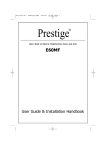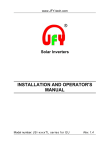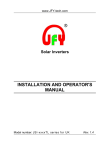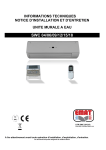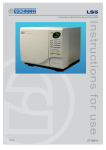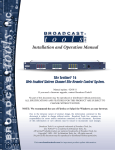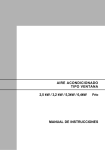Download GENUS TRAINING
Transcript
GENUS TRAINING Genus Training • Operation of Genus • Microwaves • • Genus Technology Overview • Troubleshooting • Safety • • • • • • • • • • • User Manual Special Functions What and How ? Measuring Microwave Power Leakage Measurement Differences Mechanical Build Wiring and Circuit Diagrams Flowchart Component Check Do’s and Don’ts Operation of Genus THE TECHNOLOGY Top oven / grill functions: Conventional Base heat Full grill Half grill Intuitive rotary control: Main oven functions: Genus mode Multifunction (16 interactive modes) Defrost Press / turn 360o On/Off Lights only mode (push and hold) Factory set clock Programme (both ovens) Time setting Temp adjust before & during cooking Volume control Revolutionary cooker, Remarkable results Special Functions • To access special functions depress the centre control knob. All available icons will illuminate in red. • G functions 1-8 can be activated for special functions by touching and holding the numbered icon for 5 seconds. Special Functions • G1 – Microwave Power Test Runs Microwave power for 170 seconds • G2 – Auto Sequence Test Mode Runs through each relay/triac operation and displays expected power output • G3 – Manual Sequence Test Mode As above but can be switched manually through each one using rotary control knob • G7 – Demonstration Mode Appliance operates as normal but switches no relays on. Can be operated from a 13A Plug (3A Fuse) • G8 – Volume Control Will operate audible tone and allow the volume to be changed using the rotary control. • Lights only mode – Press and hold centre control knob for 10 seconds. Special Functions G2 and G3 Left Hand Display Right Hand Display Frequency Stirrer t1 58 T O Lights t2 50 Cooling Fan t3 70 Convection Element rl1 2300 M O Grill Inner Element rl2 1800 T O Grill Outer Element rl3 1000 M O Grill Outer Element rl4 1000 M O Base Outer Element rl5 1000 Low Microwave rl7 540 Medium Microwave rl8 1000 High Microwave rl9 1600 T O Grill Inner Element rl12 1800 T O Base Element rl15 765 t4 20 Component M O Lights Software 4-00 Setting The Clock • • • • Depress the centre control knob Touch and hold the ‘Cook Time’ Icon The display should flash ‘Year’ ‘2005’ Note: If the display flashes ‘Year’ ‘2000’ this is an indication that the battery is flat • The display will then go through each of the set parameters in turn. • These can be adjusted by rotating the central control knob Setting The Clock • • • • • • • The display will show the following:‘YEAR’ – Set Year ‘Cal’ – Set Month ‘Day’ – Set day of week (00 – Sunday) ‘Date’ – Set Date ‘Hour’ – Set Hour ‘Blank’ – Set Minute Microwaves What are they and How do they cook? What are Microwaves • Electromagnetic Radiation • Energy rays that are either reflected or emitted as radiation by objects. X-rays, ultraviolet light, visible light, near-infrared light, and heat (thermal) radiation are different wavelengths of electromagnetic energy. Electromagnetic Spectrum Conduct through free air Effect of Electromagnetic Radiation • Higher frequencies have higher quantum energy – Ionising Radiation • Ionising Radiation - Any form of radiation that has sufficient energy to remove electrons from atoms, so producing charged particles called ions. Short wavelength electromagnetic radiation (ultraviolet, X-rays and gamma rays). • Lower frequencies have low quantum energy - Non Ionising Radiation • RF and Microwaves do not have sufficient energy to remove electrons from atoms. Wavelength Calculation Speed of Light C = 3 x 108 m/s (299,792,458 m/s) Wavelengths Microwave Wavelength 299,792,458/2,450,000,000= 122.36 mm Electromagnetic Radiation • E Field- This is the electric part of the wave. It causes arcing in metallic objects and causes intense hot spots in the cavity and is suppressed. It is measured in volts • H Field- This is the magnetic part of the wave. It does not cause arcing and distributes the energy more evenly around the cavity, creating fewer hot spots. It is enhanced in the cavity. Electromagnetic Radiation Wavelength • Wavelength. This is the distance from one point in the wave to the same point on the next wave. A peak to a peak, or trough to a trough or any point in between. It is a measure of the ‘size’ of the wave. The shorter the wavelength, the smaller the objects it affects. Electromagnetic Radiation • • Frequency. This is the number of complete waves that pass a specified, fixed point in one second. The frequency of microwaves is 2.45GHz. That means that 2,450,000,000 waves pass a specified, fixed point in one second. • Because the speed of electromagnetic waves is set at 3 million metres per second, and the speed of a wave is the frequency multiplied by the wavelength, if the frequency of an electromagnetic wave changes, so must the wavelength. Electromagnetic Radiation • • • Amplitude. This is the vertical distance from the top of one peak of a wave to the bottom of a trough. It is a measure of the energy in a wave. A wave with a large amplitude has a larger energy than a wave with a smaller amplitude. Electromagnetic Radiation • • • Node. In a standing wave, the area of minimum displacement is called a Node. This is where the two waves interfere with each other to produce an area of no displacement. That is, the amplitude is zero. At these points there is no heating effect. Electromagnetic Radiation • • • Antinode. This it the opposite of a node. This is where the two waves interfere with each other to produce an area of maximum displacement, one that is twice the amplitude of one wave on its own. This is an area of maximum heating effect. Electromagnetic Radiation • • • • Modes. Imperfectly Matched, not a mode A mode is a wave that is perfectly matched to the space it inhabits. Thus a mode is a wave that has become a standing wave, and as such has node and Perfectly matched, thus a mode anti-nodes. The more modes than can be created in a cavity, the more anti-nodes there will be and as such the energy will be distributed amongst more hot spots, decreasing their intensity. Cavity How Do Microwaves Cook ? • Microwaves have a frequency of 2.45 GHz (2,450,000,000 times a second) • Food is made up of molecules with positive and negative parts which act like little magnets • As the microwave energy switches from positive to negative so do the molecules in the food. As the molecules flip back and forth friction occurs causing heat. Measuring Microwave Power • • • • • • Using two microwave safe containers place 1 litre of water in each (2 litres total) Take the average temperature of the water in both containers to 0.1°C (T1) Place the shelf on level 6 (from bottom) and place the jars in the centre of the shelf Switch on the appliance and use Special Function G1 The appliance is automatically set to run for 170 seconds When complete take the average temperature of the water in both containers (T2) Measuring Microwave Power • Use the following formula to calculate power of microwave :Power (W) = 4.187(Joules) x 2000(Quantity of Water) x K(T2-T1 Temperature Rise) 167(Magnetron on time – allows 3 second warm up) • Typical value for 900 Genus will be 500 – 550 Watts Microwave Power • A number of factors will determine the microwave power output :• The supply voltage. • The metal to metal connections within the cavity i.e good continuity between metal parts will result in higher output power. In particular those parts closest to the launch system. • Excessive leakage from around the cavity. Electromagnetic leakage • Leakage is prevented from the cavity by:- 1. The cavity itself reflects the Electromagnetic radiation. 2. Any point there is a possibility of leakage ie through holes from RTD and Element connections a metallic mesh washer is placed. 3. The door is sealed using an electromagnetic leakage prevention system (choke) Electromagnetic Leakage System • • • The system works by ‘shorting out’ electromagnetic energy at the point of egress from the appliance. Fig 4 shows that zero power will exist at a half a wavelength away from an imposed short circuit. Physics state that, over a frequency range of 2.4352.475 GHz, the half wavelength dimension is 6062mm (average 61mm) Electromagnetic Leakage System • Fig. 1 Primary Choke • Location 1 shows the gap between the cavity and the choke ditch. • The three lines are 61mm long and we impose the required short circuit condition at location 1. Electromagnetic Leakage System • • • Fig. 2. Secondary Choke Location 3 shows a gap between the cavity and the outer shell. This gap also needs to be a magnetic short circuit so as to absorb any microwaves that were not absorbed by the primary choke, due to manufacturing tolerances. The three lines are again 61mm long and using the same condition of the bottom of the choke ditch, we impose the required short circuit condition at location 3. Electromagnetic Leakage System • Fig 3 Choke 3 • Short circuits at points 1 and 3 result in a short circuit at point 4. Microwave Leakage Measurement • The power density of microwaves is determined my measuring the amount of energy that flows through one square centimetre in 1 second. • For our purpose we will be measuring values in mW/cm2 using an Apollo x 10 Microwave Monitor. Microwave Leakage • Microwaves disperse and dissipate very quickly in the atmosphere • The exposure to microwave drops by the square of the distance you move away • E.g. if you are exposed to 5mW/cm2 at 50mm and then move to 500mm (10x) the exposure will drop by a factor of 100 0.05mW/cm2 Microwave Exposure • Microwaves act by depositing energy within the material and so far as the human body is concerned, the difference between exposure to infra-red frequencies (radiant heat) and microwaves is that the former produces surface heating while the later is absorbed within the body tissue thus raising its bulk temperature. Thermal damage has been shown to occur at radiation intensifies of 100 mW/cm2 and above. Microwave Exposure • • • • In 1960 the Post Office published a guide called "Safety Precautions relating to Intense Radio-Frequency Radiation". This recommended a maximum safe working level of 10 mW/cm2, thereby setting a safety factor of 10. A committee of the Medical Research Council carried out a review in the late 1960s and their report in 1970 confirmed the 10 mW/cm2 limit for continuous exposure of personnel. It also laid down parameters for short periods of exposure at higher levels. Current draft proposals by the National Radiological Protection Board for "The Health Protection of Workers and Members of the Public against the Dangers of Extra Low Frequency, RF and Microwave Radiations" recommend the retention of the 10 mW/cm2 level for the microwave frequency band for the continuous exposure of adults. A lower figure of 5 mW/cm2 is proposed for the general public. British Standard BS 5175 : 1976 and International Electrotechnical Commission Standard IEC 335:25 requirements specify maximum leakage rates from a microwave oven in service, of not more than 5 mW/cm2 at 5 cm from any surface of the oven. Microwave Leakage Measurement • From BS EN 60335-2-25:2002 - 275g of water placed in the cavity within a borosilicate glass vessel (Pyrex) • Appliance operated on max microwave power (Special function G1) • Detector moved around external surface of appliance particular attention to door seal and corners. • Maximum allowed leakage 50W/m2 (5mW/cm2) Genus Technology Conventional Microwave • In the conventional microwave, the electromagnetic waves generated by the microwave generation circuitry have a Door frequency of 2.45GHz with a narrow bandwidth. These electromagnetic waves are guided directly into the oven. As the frequency bandwidth is narrow, only a small number of modes are produced. A mode is the name we give to a wave that is matched to the dimensions of the oven. Magnetron Narrow band Electromagnetic Waves with High ‘E’ field giving a low number of modes Turntable Conventional Microwave • These electromagnetic waves also have a very high E field, that is the electric part of an electromagnetic wave. Magnetron Door Narrow band Electromagnetic Waves with High ‘E’ field giving a low number of modes Turntable Conventional Microwave • Some of the problems associated with conventional microwaves are: 1. A small number of modes means a small number of intense hot spots. Conventional microwaves usually incorporate a turntable to try and improve the cooking performance by evening out the heating by rotating the food through the hot spots. However it does not reduce the intensity of these hot spots which damage the structure of many foods being cooked. 2. The high E field means that metal objects can cause arcing (sparking) in the oven, making them very problematic to use. 3. Launching the microwaves directly into the oven means that the quantity, size, shape etc. of food substances changes the performance of the oven. It also means that some types of food can deprive others of energy; especially when some of the foods are frozen. Also, running the microwave oven with nothing in the oven can damage the magnetron through overheating. 4. In many conventional microwave ovens it is not possible to vary the amount of power produced by the microwave generation circuitry, instead they have to pulse the power to achieve a similar, reduced effect, however the damage caused by the hot spots is still the same. Genus Oven Magnetron Separate, tuned Cavity Broadband Electromagnetic Waves with High ‘H’ field giving a high number of modes (Genus Waves) Broadband Electromagnetic Waves with High ‘E’ field Frequency Generator • In Genus the electromagnetic waves are launched into an innovative and patented, separate tuned chamber that contains a frequency stirrer. Genus Oven • This gives Genus the following advantages: 1. The frequency stirrer increases the bandwidth of the electromagnetic field which means that the number of modes in the oven are significantly increased, reducing the intensity of the hot spots and eliminating the need for a turntable. 2. The chamber is designed such that the electromagnetic waves emitted from it have enhanced H field, that is the magnetic part of the electromagnetic wave, and suppressed E field. This increases the cooking performance and solves the problem of arcing between metal surfaces. 3. The separate chamber creates a constant load which means it is possible to run Genus with nothing in the main oven without the danger of overheating and damaging the magnetron. It also means different types of food can be heated together without affecting the overall cooking performance. Genus Oven • The electrical circuitry in Genus uses the resistance of the heating elements to reduce the power developed by the magnetron, meaning the power levels can be reduced without pulsing. • Definition of the Genus wave is an electromagnetic wave of frequency 2450MHz with a broad bandwidth of +/-40MHz having a high 'H' field and a low 'E' field. THE TECHNOLOGY – Most of today’s ovens use three cooking methods to cook food… 1 Radiant heat 2 Conduction 3 Convection Conventional ovens One way round this is to cook food very slowly using much lower temperatures. 1 Food is heated from the outside inwards, which is problematic in that it over-cooks the exterior before it cooks the interior. 3 1 Conventional cooking is very inefficient as only 5% of the energy is actually used in cooking the food. This causes problems as the heat escapes through the cavity, doors, ventilation, the kitchen units and into the atmosphere. Revolutionary cooker, Remarkable results THE TECHNOLOGY - Microwaves Microwaves would look a bit like this They generate hot spots & need a turntable to drive the food through these hot spots The problem with them is they are very selective and uneven in what they cook Cooking results are inconsistent at best The electro-magnetic waves used in a conventional microwave have a stronger electric “E-Field”. This causes arcing (sparking) with metal objects such as baking trays / cutlery Revolutionary cooker, Remarkable results THE TECHNOLOGY waves are different in two main ways: 1 The Genus wave creates a myriad of tiny, compact balls of energy. This enables the food to be cooked in a more consistent way, without the need for a turntable. 1 “H” Field 2 Genus suppresses the “E” field and amplifies the “H” field. This improves the cooking results and allows the use of metal dishes / trays. 2 “E” Field Revolutionary cooker, Remarkable results THE TECHNOLOGY • - How Genus works… = + Conventional cooking base & top heat “Genus” wave The most advanced domestic oven in the World Fanned + fanned heat Genus therefore operates automatically as a multifunction oven, in Genus mode (selecting the optimum combinations for the best possible cooking results) Revolutionary cooker, Remarkable results Magnetron THE TECHNOLOGY - Frequency Stirrer This is an example of how we have programmed Genus to product superb cooking results • Fanned heat Top heat Base heat Type Genus (Full power) Genus (Medium power) Genus (Low power) Time Revolutionary cooker, Remarkable results Algorithms GENUS Function Default Time (Hours) Default Temperature 1 1.00 200 2 0.40 250 Short Warm Maximum Maximum up Time Conventional Genus Time Time Division Ratio Correction Time (Hours) (Hours) Long Warm up Time Correction Fast Warm Elements (Any PWM over a 2 minute duty cycle) but still under thermostatic control Convection Grill Inner 4.00 4.00 T/3 OFF ON OFF Thermostatic 4.00 4.00 T/3 ON OFF OFF Thermostatic PWM 50% 0 - 29 mins Thermostatic 30+ mins 50% 225 Grill Outer Microwave Power Base High Thermostatic Thermostatic High for 4.5mins then Medium 4 0.40 5 2.00 >=*35mins 190 <*35mins 170 200 4.00 4.00 T/3 OFF ON OFF Medium last 3 minutes of cooking Thermostatic On time Thermostatic Thermostatic for first 2 mins Medium last 4 minutes of cooking On for first Thermostatic for first 3 then on between 8 time 3.5 mins mins then off and 10 mins Medium last 3 minutes of cooking time Low and then Medium for last 3 Thermostatic minutes Thermostatic PWM 30% High 6 2.00 180 4.00 4.00 T/3 ON OFF OFF Thermostatic 7 0.45 200 4.00 4.00 T/3 OFF ON OFF Thermostatic 8 0.30 150 4.00 4.00 T/3 ON OFF ON Thermostatic High Defrost Def 40 (fixed) - - - - - - Thermostatic Low 25% Duty Cycle *0 - 45 mins T/3 3 1.00 170 4.00 4.00 ON OFF OFF T/3 ON OFF OFF *46 - 75 mins T/2.5 *76+ mins T/2.5 4.00 4.00 High 2.5mins then Low Thermostatic High Mechanical Build Wrap & Front Frame NOTE: Do not forget to fit the hinge ducts, Left hand and Right hand at this stage Inside Top Oven Cavity A standard 900E Stoves Premier Cavity with a 2.8Kw Dual Grill Element fitted. Rear Of Top Oven Cavity Note: No mesh washers required in this cavity M4 machine screw fitted to a M4 Eurosert to secure the RTD and elements. 2.8kW Dual grill element A new 700Watt Base element fitted after the Intermediate rear plate. Side View Of Top Oven Cavity Lamp live parts Protection must be fitted. Standard Stoves Premier 600EMa light harness. Wave Guide Wipe Prior to fitting the magnetron plate and magnetron, using emery cloth, remove all residue from around the wave guide opening to enable a true conductive path between the cavity and the magnetron. Inside Of Main Oven Cavity RTD NOTE: Fit Mica shield Into slot in launch box Prior to fitting the match Plate. NOTE: Mesh washers To be fitted on all element tails and the RTD prior to Securing them in the cavity. Mica Fitting Fit M5 Hexserts and use M5 Pozi pan screws to secure all Elements and the RTD in the Main oven cavity only. Use 2 off screws to secure the Mica strip to the launch box. Main Oven Rear Insulation Main Oven Wrap Centre Vent Duct Centre Duct Front View Cavities and Centre Duct Intermediate Rear Fitting L70c thermal cut out x 3 Intermediate Top Fitting L100c Thermal Cut out Top & Main Oven Base Elements Microwave Transformer Capacitor & Diode Microwave Transformer Cap & Diode Wire Connections Transformer Enclosure The orange and blue wires must be fitted this way round to avoid interference Main Oven RTD Magnetron Thermal Cut out Wiring Magnetron Spacer Magnetron Thermal Cut Out Position L100c Thermal cut out Assembly Of Magnetron Assembly of Bracket & Cooling Fan Connection to the Interface Note the correct terminating point for both the Main and Top oven RTD’s. The Main oven RTD has a black dot marked on it. Interface Earth Connection General Rear View Troubleshooting Troubleshooting • SAFETY FIRST • Ensure the appliance is switched off • Whenever you remove the rear of the appliance ALWAYS DISCHARGE THE HIGH VOLTAGE CAPACITOR Troubleshooting • • • • • • SAFETY FIRST-BE SAFE NOT SORRY Use the available wiring and circuit diagrams. Work in a logical and methodical manner. If required use special function G3 Example flowchart 1 – No Display on Fascia Example flowchart 2 – Poor Cooking Performance Discharging Capacitor • Ensure appliance is switched off at the mains. • Using discharge lead place the earth probe on the chassis (ground), touch the other end of the lead on one of the capacitor terminals leave for a few seconds. • Repeat with second terminal to chassis • NOTE: The discharge lead should have a nominal resistance of 270Ω which should be checked on a regular basis Capacitor Test Procedure • • • • • • • Switch off appliance Discharge High Voltage Capacitor Remove leads (Noting there position) Put your meter on the highest Resistance ohm scale Connect across the two capacitor terminals. The reading should increase and then slowly decrease as the capacitor is charged. Reverse the leads and the effect should be repeated. If you have a meter with a capacitor test feature use this and the meter should read approx 1.2µF Magnetron Test Procedure • • • • Switch off appliance Discharge High Voltage Capacitor Disconnect plug from magnetron Using the resistance reading on the meter check across the two terminals of the magnetron, this should read less than 1 ohm • Check the reading from each terminal to the magnetron casing, this should read infinity. High Voltage Transformer Test • • • • • • • Switch off appliance Discharge High Voltage Capacitor Disconnect primary winding connections (Blue and Orange), unplug from magnetron and remove leads from capacitor (Noting lead connections) Set meter to read resistance Primary winding (6.3mm Male terminals) – Approx 2 ohms Filament Coil (Leads on molex plug) – less than 1 ohm High Voltage Secondary (Single red lead from transformer with 6.3 receptacle to body of transformer)– Approx 90 ohms (Note: Ensure insulation on transformer body is cleared to obtain a true reading.) Diode Test Procedure • • • • Switch off appliance Discharge High Voltage Capacitor Disconnect the diode (Noting the connections) Using a Insulation Resistance meter (Megger) put the leads across the diode and test, reverse the leads and retest, continuity (closed circuit) should be seen in one direction and infinity (open circuit) in the other. Fault Codes • • • • F1 F2 F3 F4 – – – – Main Oven RTD Failure Top Oven RTD Failure Thermal Cut Out Operated Low Voltage Transformer Polarity RTD Test Procedure (F1, F2) • • • • Switch off appliance at the mains Disconnect the RTD Set the meter to read resistance (ohms) Check the resistance of the RTD by placing the leads across the Molex plug. • The resistance should read approximately 1000 ohms (1kohm) • Note: The resistance should increase with temperature. Thermal Cut Out Test Procedure (F3) • • • • • • These cut outs are for fan fail scenarios Switch off appliance Discharge High Voltage Capacitor Remove Molex plug from CT29 Set the meter to read resistance (ohms) The meter should read zero or short circuit. Low Voltage Transformer Test • Switch off appliance • Discharge High Voltage Capacitor • Disconnect Low Voltage Transformer Molex plug from CT15 • Set meter to read resistance (ohms) • Primary Winding (Brown – Blue) – 30Ω • Secondary Winding (Orange – Black) – 0.5Ω Door Safety Circuit Primary Door Switch 10A Fuse Direction of Current Monitor Door Closed Must open before primary and secondary are closed Secondary Door Switch Door Safety Circuit Failure of Primary and Monitor Monitor and Primary closed, secondary open- Creates a short circuit and blows the fuse. 10A Fuse Direction of Current Monitor Secondary Door Switch Failure of Secondary Primary open, monitor closed, Secondary closed. No current can flow 10A Fuse No current can flow Monitor Secondary Door Switch Door Safety Circuit Primary Door Switch 10A Fuse No Current Door Open Monitor Secondary Door Switch Door Safety Circuit Test • • • • • • Switch off appliance at the mains Discharge High Voltage Capacitor Disconnect the door safety circuit from the power board (remove CT19 and white lead from CT22) With the meter set to read resistance you should get a short circuit across these two connections when the door is closed and an open circuit when the door is open. If an open circuit is detected the problem could be with the door switch assembly or the magnetron thermal cut out. NOTE: If the fault is that the appliance is flashing door when it is closed this could be due to the magnetron thermal cut out, power board, ribbon cable or fascia pcb. Recommended Parts List • • • • • • • • • PCBA Fascia - 012550437 PCB Power Board - 082572700 Frequency Stir Blade - 0825665-00 Door Microswitch Assembly - 082575800 Low Voltage Transformer - 082573700 Main Oven Lamps - 082573200 Stir Motor - 0825700-00 2A Fuse (T250V)- Electronics 10A Fuse (250V) – Door Monitor Safety • Where possible switch off appliance before starting work. • WITH POWER OFF ALWAYS DISCHARGE THE HIGH VOLTAGE CAPACITOR • Leave yourself enough space to work around the appliance. • Check the leakage BEFORE and AFTER repairing the appliance. • Check the operation of the door safety switch before leaving the appliance. • Wear relevant PPE (Gloves etc) REMEMBER • Be safe not sorry • Most work can be done with the appliance off • If the anti tamper label has been removed proceed with caution. Has somebody tampered with the appliance! • The ‘Low Voltage’ can be just as lethal as the ‘High Voltage’ • Check Leakage before leaving appliance • Reapply anti tamper label to casing when work is complete Wiring & Circuit Diagrams 900 ELECTRIC RAPID COOK ISSUE II CIRCUIT DIAGRAM 02/03/2005 PRIORITY No. 2 Total Power (W) - 4615 @ 240v Total Current (A) - 15.1 @ 240v PRIORITY No. 1 Total Power (W) - 7816 @ 240v Total Current (A) - 32.6 @ 240v WELLING TXMR BWL - A01F - 03 Filter Circuit K15 16Amp Top oven Grill outer element 1000W Top oven base element 765W Top Oven Lights Filament Type 2 x 25w TOP OVEN THERMAL CUTOUT 100°C 16Amp POWER COOLING FAN 58W X1 100 nf Capacitor 275volts 230v Transformer. 20 watts for the lamps and 20watts for driving the relays and controling the interface. PROVISIONAL SWITCH IDENTIFICATION: K1 20Amp MAIN OVEN FREQUENCY STIRRER 38W Top oven Grill inner element 1800W PANASONIC MAGNETRON 2M 167 K 6 Triac K18 Triac BJB 77.914 MAIN OVEN LIGHTS 2X10watts each RELAY POWER OUTPUT (W) K 1 - 20Amp RED HIGHLITES INDICATE MICROWAVE CIRCUIT. GREEN HIGHLITES INDICATE NON RELAY SWITCHES K 2 - 20Amp K 3 - 16Amp K 4 - 16Amp K 5 - 16Amp K 6 Triac K 7 - 16Amp K 8 - 16Amp K 9 - 20Amp K10 - MOSFET Transitor K11 - Triac K 12 - 20Amp K15 - 16Amp K18 - Triac Main oven convetor element 2300W K4 16Amp Main oven grill outer 1000W K2 20Amp Main oven grill inner 1800W 230V 240V 256V 2110W 1655W 920W 920W 920W 53W 1655W 725W 1470W 18W 53W 1655W 700W 23W 2300W 1800W 1000W 1000W 1000W 38W 1800W 790W 1600W 20W 58W 1800W 765W 25W 2620W 2050W 1135W 1135W 1135W 66W 2050W 900W 1820W 23W 66W 2050W 870W 28W K7 & K8 16Amp Microwave Medium Main oven base outer 1000W K7 16Amp Microwave Low DOOR SWICTH MONITOR N.C. MAIN OVEN THERMAL CUTOUT B L70°C ? 16Amp MAIN OVEN THERMAL CUTOUT A L70°C ? 16Amp K8 K5 16Amp Main Oven Base Element 1800 watts DIODE 350mA K7 K 9 - 20Amp Microwave High 1600W SAFE WORKING AT 256V It is important that all components are garanteed for at least 200.000 life cycles @ 256volts Note: All element power ratings are quoted at 240volts Mark Hope: Technical Centre HV CAPACITOR 1.2mF @ 2100VOLTS (rms) with rapid discharge resistor SECONDARY DOOR SWITCH K10 MOSFET Transitor 12volts K3 16Amp PRIMARY DOOR SWITCH FUSE 10A K11 Triac K12 20Amp MAGNETRON THERMAL CUTOUT 100°C 900E RAPID COOK MICROWAVE D.O.- Wiring Diagram: ISSUE A Brown 780mm Brown 690mm Brown 780mm Brown 860mm MAINS INLET TERMINAL BLOCK N L Black 620mm TOP OVEN GRILL ELEMENT Green 580mm Green 500mm Black 470mm Black 420mm L100°C 16Amp Thermal Cutout Yellow 580mm Orange 960mm Brown 510mm Black 220mm White 510mm Orange 590mm Black 110mm T3 CT20 R1 T1 T2 R6 Green 800mm FS1 CT1 CT3 CT4 TOP OVEN BASE ELEMENT K3 CT2 K12 CT5 K15 CT6 K1 R11 Red 370mm C1 R5 R7 C4 CT18 R3 Q3 CT16 CT9 CT7 Brown 290mm K4 CT23 R13 K2 Q5 White 470mm CT13 R26 R24 R22 R23 R19 R25 R8 R21 R20 R9 R29 R12 IC1 L70°C 16Amp Thermal Cutout C17 Q4 IC6 Black 120mm Orange 300mm K8 CT8 R10 Green 200mm Black 900mm IC3 IC5 IC4 CT17 MAIN OVEN GRILL ELEMENT R28 Green 930mm IC2 Green 1000mm Q2 D1 C2 CT10 D5 Red 290mm R27 C12 D4 R2 K5 R15 C3 MAIN OVEN CONVECTION FAN ELEMENT Green 120mm Black 630mm Brown 330mm D2 R17 CT11 K7 Q1 R18 Black 120mm R14 CT24 C11 Brown 860mm L70°C 16Amp Thermal Cutout FS2 R16 C13 CT19 C5 Brown 860mm C8 L1 Blue 500mm Black 620mm C6 C7 CT29 CT14 D7 IC7 R4 D3 MAIN OVEN BASE ELEMENT D6 CT25 CT22 CT50 K9 CT15 CT150 CT21 Green 120mm Blue 630mm Orange 500mm Black 920mm White 1000mm MAIN APPLIANCE COOLING FAN Black 120mm Blue 520mm TRANSFORMER Transformer 50 40 VA VA 9v Red 1360mm Red 900mm Terminal Block for Cooling Fan MAIN OVEN FREQUENCY STIRRER VIDAFLEX 500mm Black 120mm Black 470mm Vidaflex Sleeving Orange 1000mm Green 1000mm Terminal Block for Top Oven Lights Main Oven Lights 120°C 16Amp Thermal Cutout MAGNETRON EARTH POINT CHASSIS Red 280mm CAPACITOR DIODE ARRANGEMENT Red 460mm Blue 750mm Red 1360mm MICROWAVE TRANSFORMER Green 1000mm Blue 500mm L70°C 16Amp Fan Stall Centre Duct Thermal Cutout Yellow 310mm Red 450mm DIODE Red 900mm Red 1220mm Orange 500mm Blue 500mm Green 1000mm White 1000mm MICROWAVE PRIMARY DOOR SWITCH NO Brown 120mm Unless otherwise specified, all cable on this harness where the load (power in watts) carry’s greater than 100Watts must be made from Silicon Elastima and have a 1.0mm2 cross sectional area It must also be capable of withstanding 16Amps plus 180°C continuous. If in doubt check power ratings of elements on page 8. L70°C 16Amp Fan Stall Intermediate Top Tray Thermal Cutout NC MICROWAVE DOOR SWITCH MONITOR NO Brown 120mm NC MICROWAVE SECONDARY DOOR SWITCH NO Red 1220mm Red 1360mm NC © This diagram is the property of Glen Dimplex Cooking Limited. Not to be reproduced or transmitted in any shape or form without the permission of Glen Dimplex Cooking Limited. 28/02/2005




































































































